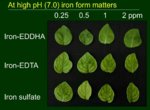I have to respectfully disagree with you on large parts of your comment and reasoning aiki_joker.
I will see if I can find the time to pick it apart and provide my views on the parts I disagree with.
Complex = chelating agent + ion.
A complex can be dissolved, but the ion within it is trapped, it is part of the molecule, not dissolved as itself. Same as the ammonia in amino acids is not readily available, simple because it is stuck to the amino acid molecule. My chemistry teacher has used that example to make it very, very, clear that a chelated ion can not react, unless it's free, and out of the complex.
A complex can lose it's metal through exchange with another ion or ions. But this happens only if the conditions are met. Plants have the ability to excrete acids or bases in their rhizosphere based on the soil pH, thus are able to exchange with chelating agents, even without the help of changing acidity.
As for clay, it has bot a cationic and anionic exchange capability, making it the ideal buffer material for soils. Many buffers and even chemical industry ion exchangers are based on that ability of clay. There's a reason why, when measuring the pH of clay, or soils in general, both pH and pOH are measured; pH in pure water, pOH in KCl solution (the Cl- replaces the OH-; anionic exchange) and the pH is in the center of the two. Any garden manual will have a chapter on that. Don't trust me on this one, I know bonsai soils are very special ;-)
Whatever we disagree on, chelated iron is awesome stuff. I usually go for all trace elements in one go, because a deficiency on one side, usually corresponds with a def. On the other side as well. The cal-mag issue, or the mg-fe issue. Sometimes they're so hard to distinguish from each other, that it's less of a hassle to just dose "trace elements" all in one go. The stuff I use has edta, eddha and even some experimental humic/fulvic acids acting as chelators.







